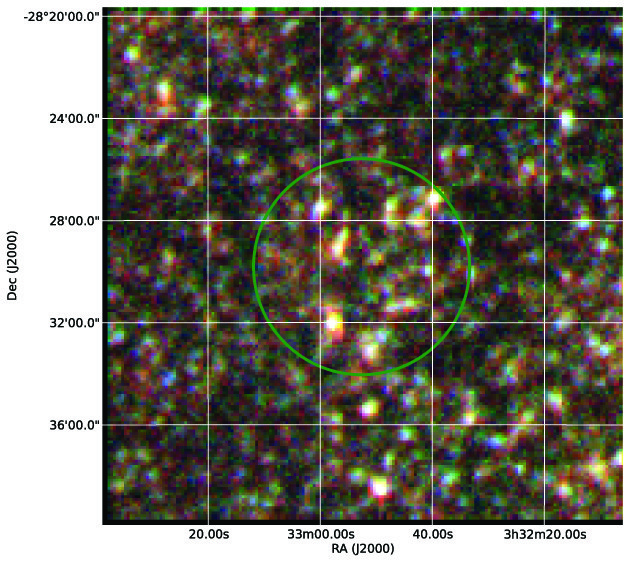Four new galaxy clusters discovered some 10 billion light years from Earth
February 14, 2014

Color image of the clumps identified by Planck. Blue, green and red represent infrared light at successively longer wavelengths. (Credit: D. Clements/ESA/NASA)
An international team of astronomers led by Imperial College London has identified four new distant galaxy clusters — more than has previously been possible — using a new way of combining data from the two European Space Agency satellites, Planck and Herschel.
The researchers believe up to 2000 further clusters could be identified using this technique, helping to build a more detailed timeline of how clusters are formed.
Galaxy clusters are the most massive objects in the universe, containing hundreds to thousands of galaxies, bound together by gravity. While astronomers have identified many nearby clusters, they need to go further back in time to understand how these structures are formed. This means finding clusters at greater distances from the Earth.
Light from 10 billion years ago
The light from the most distant of the four new clusters identified by the team has taken over 10 billion years to reach us. This means the researchers are seeing what the cluster looked like when the universe was just three billion years old.
Lead researcher David Clements, from the Department of Physics at Imperial College London, explains: “Although we’re able to see individual galaxies that go further back in time, up to now, the most distant clusters found by astronomers date back to when the universe was 4.5 billion years old. This equates to around nine billion light years away. Our new approach has already found a cluster in existence much earlier than that, and we believe it has the potential to go even further.”
The clusters can be identified at such distances because they contain galaxies in which huge amounts of dust and gas are being formed into stars. This process emits light that can be picked up by the satellite surveys.
Galaxies are divided into two types: elliptical galaxies that have many stars, but little dust and gas; and spiral galaxies like our own, the Milky Way, which contain lots of dust and gas. Most clusters in the universe today are dominated by giant elliptical galaxies in which the dust and gas has already been formed into stars.
“What we believe we are seeing in these distant clusters are giant elliptical galaxies in the process of being formed,” says Clements.
The research involved scientists from the UK, Spain, USA, Canada, Italy and South Africa. It is published in the Monthly Notices of the Royal Astronomical Society.
Abstract of Monthly Notices of the Royal Astronomical Society paper
The potential for Planck to detect clusters of dusty, star-forming galaxies at z > 1 is tested by examining the Herschel-SPIRE images of Planck Early Release Compact Source Catalog sources lying in fields observed by the Herschel Multitiered Extragalactic Survey. Of the 16 Planck sources that lie in the ∼90 sq. deg. examined, we find that 12 are associated with single bright Herschel sources. The remaining four are associated with overdensities of Herschel sources, making them candidate clusters of dusty, star-forming galaxies. We use complementary optical/near-IR data for these ‘clumps’ to test this idea, and find evidence for the presence of galaxy clusters in all four cases. We use photometric redshifts and red sequence galaxies to estimate the redshifts of these clusters, finding that they range from 0.8 to 2.3. These redshifts imply that the Herschel sources in these clusters, which contribute to the detected Planck flux, are forming stars very rapidly, with typical total cluster star formation rates >1000 M⊙ yr−1. The high-redshift clusters discovered in these observations are used to constrain the epoch of cluster galaxy formation, finding that the galaxies in our clusters are 1–1.5 Gyr old at z ∼ 1–2. Prospects for the discovery of further clusters of dusty galaxies are discussed, using not only all sky Planck surveys, but also deeper, smaller area, Herschel surveys.
